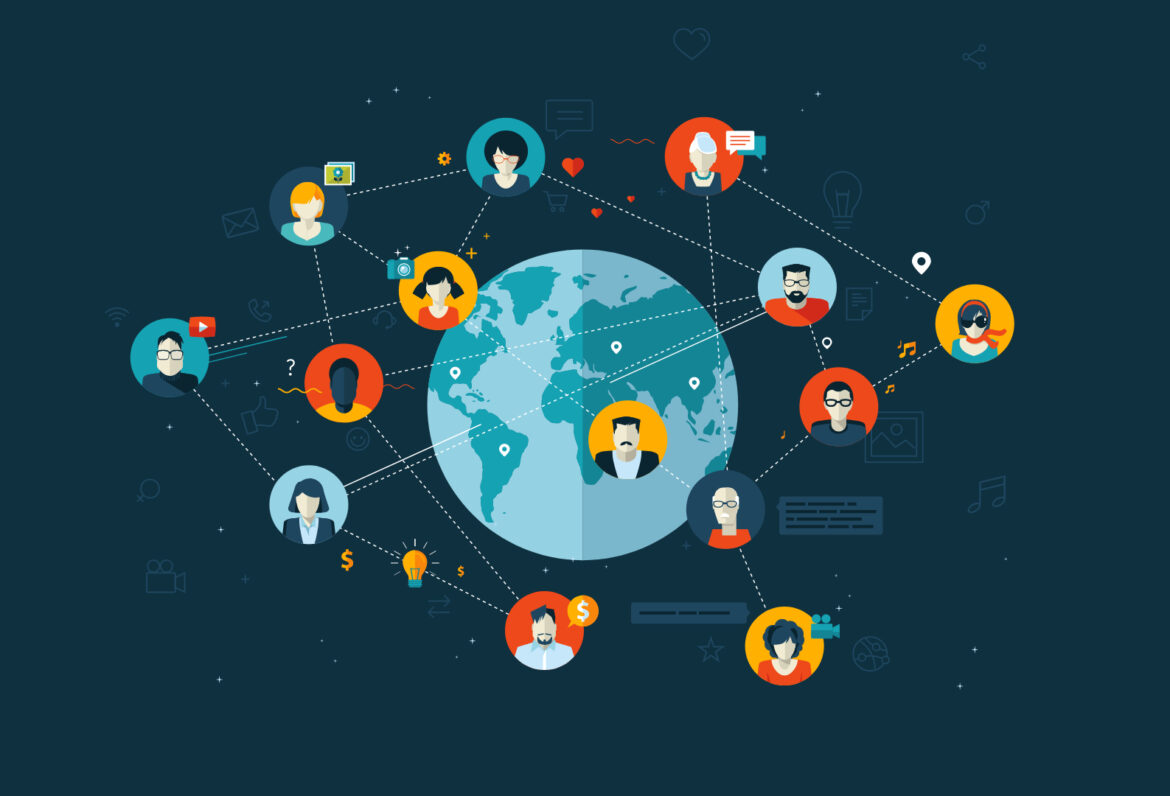Some feel like fish in the water at networking events. They chat and connect with ease. Others don’t enjoy networking events because they feel phony and superficial.
Because of the pandemic, physical networking events — and with them, awkward handshakes and fake smiles — are a thing of the past. Today, we connect via video calls, social media, and other digital channels.
Perhaps, attending traditional networking events will never be as important as it once was.
While this may be a relief for many, it doesn’t absolve us from networking altogether. Having a great product or idea gets you nowhere if you don’t get it across to the right people. You need investors, employees, partners, and so on.
Skills alone have never been enough, and they never will be.
The challenge of networking in 2021 — Connecting is too easy.
It’s become effortless to meet new people. After all, you have access to them 24/7 over social media and email.
“That’s awesome! I can say ‘Hi’ to hundreds of people a day now,” some might say.
And that’s right. But so can everyone else. Through social media, everyone can send a message to Mark Zuckerberg, Elon Musk, or the directors of the chambers of commerce. Standing out is more challenging than ever.
Easy access also makes people lazy. They mistake sending a connection request on LinkedIn for actual networking. This leaves them with hundreds of meaningless contacts on their profile.
Having an extensive network is overwhelming.
On average, a LinkedIn user has over 930 connections. That’s a big network. It’s also worthless if you haven’t built any relationship with those people.
Robin Dunbar has found out that humans can only maintain a maximum of 150 stable relationships. From those 150, not even 20% are close.
Choose your network wisely.
Think about your own circle. How many people would you invest time and money in? How many do you care about? How many are you in regular exchange with?
Whenever you expand your network with a new person, be sure you’re able to form a meaningful relationship that provides value for both sides.
While having a big network looks good, having a small network that’s built on good relationships will get you infinitely further.
Where and how to network in 2021 — 8 ways to meet the right people without leaving your house.
Because of the pandemic, we can’t do traditional networking events, business lunches, or meetups. You still won’t get around networking, though. You just have to find the right place.
Finding the right place means you have to be wherever the conversation you’re interested in is already happening. Wherever people are that could benefit from your product or service, you want to be there too.
Without further ado, here are the 8 best ways to network in 2021.
Digital networking events.
Like many other booming ex-physical-now-online activities, digital networking events are on the rise.
You can join events from anywhere in the world from the comfort of your living room — with a drink from your fridge.
Or a hot coffee, for that matter: Sébastien Meunier is inviting you to a virtual coffee break. Join a small crowd to talk technology, organization of work or challenges or simply to have a little chat. Sébastien awaits you every Tuesday from 8 to 8.30 or on Wednesday from 3 to 3.30 pm. Just drop him a line to receive your invitation: sebastien.meunier@baselarea.swiss.
To find an event you want to join, take a look at Eventbrite. They host dozens of events in various categories like tech, medtech, and biotech. Most of them are free to join, too!
Make sure you hit the right tone: If the event is for casual networking, don’t overwhelm everyone with your pitch. Try to enjoy conversations and helping others instead of holding monologues.
Connect on LinkedIn.
LinkedIn is the easiest and most common social media platform for business people. Meeting new people by clicking the ‘Connect’ button is easy and instant. Though, if that’s all you do, it won’t get you far.
At the beginning of this article, I talked about building relationships instead of collecting connections. Here are some tips on how you build meaningful relationships via LinkedIn.
- Do your homework. If we meet someone at an event, we can’t research them. But when you’re meeting someone on LinkedIn, you can — and you should. Scroll through their profile and find out what they like, dislike, who they are, and who they dream to be.
- Be different. Don’t send the same copy-paste message to everyone you want to connect with. You’ve done your homework. You know a thing or two about the person you’re talking to. Getting a personalized message shows the reader you care, and in turn, makes them care as well.
- Interact. Being connected isn’t enough. To build a relationship, you have to interact with people. Like their articles, comment on their posts, send them articles they might find interesting, etc.
- Ask for an informational interview. People like talking about themselves and what they do. Ask them all about it in an informational interview. Learning about them is interesting, and it will also get you talking about what you do.
DM on Instagram.
LinkedIn isn’t the only platform you can use to connect with potential customers, investors, and business partners.
The times when only adolescents were using Instagram are over. Everyone is on Instagram now and just a tap away.
With the direct messaging function, you could send a message to Elon Musk or Nicolas Hayek. With over 1 billion active users, you can be sure the people you’re looking for are on it, too.
There are six steps to finding and connecting with the right people on Instagram:
- Find new accounts. Use the hashtag search function to look for people or companies that may be interested in what you’re selling.
- Study the account. Once you’ve found an account of someone potentially interested, take some time to study their posts, likes, and the profiles they follow. This will help you send a personalized, meaningful message.
- Create value. What value can you provide for this person or company? Can you help them solve a problem? Don’t just pitch your product or idea. You have to give before you can get.
- Send a direct message (DM). When you are on their profile, you’ll see a big ‘Message’ button. Click it and send your meaningful, value-packed message.
- Follow up. Sometimes (mostly), you won’t get an answer straight away. Sometimes they don’t see the message, and sometimes it’s just bad timing. Don’t get discouraged. Change your angle, and send them another message.
- Repeat. You can do this with dozens of people every day. It’s a numbers game. It’s tedious, but it will get you results.
Once you get talking, make an effort to stay in touch by liking their pictures, commenting on their post, and sending messages with value.
Join the conversation on Twitter.
Twitter is the third social media platform you should look at.
Interesting discussions are happening all over Twitter, waiting for you to join.
Before you participate, I’d recommend you read and learn. Twitter has its peculiarities. For example, your posts can only contain up to 280 characters, and you should be familiar with hashtags — otherwise, your posts get lost in the Twitter realm.
Once you’re familiar with the basics, engage in conversations. Tweeting is a wonderful way of communicating. It’s swift and fun! Send a few tweets here and there, respond to things you find interesting, and see what responses you get.
If you like or share someone else’s tweet, do a quick fact check first. You don’t want to weaken your credibility by spreading false information. And always keep it civil! Losing your cool on Twitter is a bad look.
Build your own community.
Most entrepreneurs and founders have the hardest time finding financing. When Seth Godin, a famous American entrepreneur, just whispers to his network that he’s launching a new product, it’s funded within days.
It’s not because Seth gets lucky. He has spent over a decade building his own community.
Instead of two-way relationships, he connects everyone through Facebook- and Mastermind groups, online events and webinars, social media, emails, and public speaking.
Revive old connections.
Your network is probably bigger than you think. All the people you’ve met in your career life are part of that network, even if you don’t talk regularly. It’s time to revive these old connections. Reviving old connections has a great advantage over forming new ones: The old connections know and trust you already.
Start by saying thank you.
I’m sure you’ve met people in your career that taught you something important. Thank them for it in your email. Ask them what they are up to now and if they feel like catching up.
Make introductions.
Do you know a guy who knows a guy? If so, you know they are well connected. They built their network by introducing the right people to each other.
When you know someone who could help someone else you know, introduce them to each other via email. They’ll be thankful you set them up. Soon, they will refer to you as ‘the guy who knows a guy.’
People will introduce their contacts to you, hoping you can help them meet the right person. You will have made a new contact as well. Like that, your network builds itself, slowly but steady.
Join online courses and workshops.
Courses and workshops are a meeting place for ambitious people with big plans and similar goals. You can join with another goal in mind: networking.
People in courses and workshops aren’t there for your pitch, though. That’s why you need to make sure you come off as a new friend rather than someone looking to do business. Here’s how:
- Who do you want to meet? Think about the kind of person you want to meet. Is it a customer? Investor? Business partner? What drives them? What do they like, and what do they fear?
- What course or workshop would they attend? Once you know their goals, desires, and fears, you can figure out what kind of course or workshop they would attend. Register for the same one.
- How can you get in touch? Not all platforms allow participants to communicate with each other. Before you join, you have to find out how you can get in touch with others. Maybe there is an exclusive Facebook group you get in, or you can use the list of participants to send out LinkedIn connection requests.
- Why would they want to get in touch with you? As with all the other methods, you have to provide value to your new connection. Straight-up pitching them your product will come off as sales-y and intrusive.
By the way, this strategy works for webinars as well!
Conclusion.
To the dismay of some — and the joy of others — networking is still alive and kicking. The only difference is that we can’t hold physical networking events anymore and shift things online, as we do in many other areas.
This new way of networking is challenging. The rules have changed. You can shake hands with hundreds of people across the globe every day. But if you don’t make an effort to build a relationship with those people, the connections are superficial, and nobody benefits in any way.
If you find it challenging to build relationships with strangers, read How to Win Friends and Influence People by Dale Carnegie. It’ll polish your social skills and set you up for successful networking.
If you’re struggling with finding new customers, read our definite guide to finding new customers.



